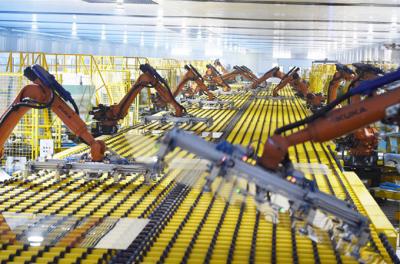
With the widespread application of clean solar energy and the gradual maturity of energy storage technology, the advantages of all-in-one solar lamp in road lighting and rural beautification are gradually becoming evident, and replacing grid-powered streetlights has become a trend.
All-in-one solar lamps use solar photovoltaic cells to provide power. As a green and environmentally friendly new energy source, solar energy is inexhaustible and renewable. Making full use of solar energy resources has positive significance for alleviating the tight situation of conventional energy.
The installation of all-in-one solar lamps is simple and convenient. Unlike ordinary streetlights that require extensive groundwork such as laying cables, they only need a base for fixing. All wiring and control parts are placed within the lamp stand, forming an integrated unit.
All-in-one solar lamps use solar power from the energy solar generator. Apart from a small amount of electricity cost when switching to grid power on cloudy and rainy days, the operating cost is almost zero. The entire system operates under automatic control, requiring no manual intervention and incurring almost no maintenance costs.
During installation, there is no need for complex wiring; just a concrete base and a battery pit within 1 meter are needed, fixed with galvanized bolts.
In contrast, grid-powered streetlights require a complex installation process involving cable laying, trenching, pipe installation, wiring, and extensive civil construction, consuming a large amount of labor, material, and financial resources. Troubleshooting issues can also result in significant costs.
All-in-one solar lamps require a one-time investment with long-term benefits. Their simple wiring incurs no maintenance costs and no expensive electricity bills. The investment can be recovered in 6-7 years, saving over a million in electricity and maintenance costs in the following 3-4 years.
Grid-powered streetlights have high electricity costs and complex wiring that requires ongoing maintenance. Voltage instability often leads to sodium lamp failures, and as the system ages, the cost of repairs increases yearly.
All-in-one solar lamps operate at a low voltage of 12-24V, providing stable and reliable operation with no safety hazards. They are ideal for eco-communities and road administration departments.
Grid-powered streetlights pose significant safety risks. Changing living environments, road reconstruction, landscape projects, unstable power supply, and the cross-construction of water, gas, and power pipelines bring many potential hazards.
The all-in-one solar lamp add new selling points for the development and promotion of high-end eco-communities. They can sustainably reduce property management costs and reduce the shared expenses of homeowners. The inherent characteristics of solar lighting, such as safety, energy efficiency, environmental friendliness, simple installation, automatic control, and maintenance-free operation, provide clear advantages for real estate sales and municipal projects.
Solar lighting fixtures have a much longer lifespan than ordinary electric fixtures. The main component of solar lights, the solar cell module, has a lifespan of 25 years. Low-pressure sodium lamps have an average lifespan of 18,000 hours, low-pressure high-efficiency three-color energy-saving lamps last 6,000 hours, ultra-bright LEDs last more than 50,000 hours, and solar-specific batteries last 2-5 years for those under 38AH and 3-7 years for those between 38-150AH. According to local pricing regulations, the initial investment in ordinary lamps is much higher than that of solar lamps. Overall, the investment-saving characteristics of solar lighting fixtures are quite significant.


